Skunk#18
RSP 11038
Grower: The Nature Farm
General Information
- Accession Date
- November 19, 2017
- Reported Plant Sex
- Female
- Report Type
- StrainSEEK v2 3.2Mb
- DNA Extracted From
- Stem
The strain rarity visualization shows how distant the strain is from the other cultivars in the Kannapedia database. The y-axis represents genetic distance, getting farther as you go up. The width of the visualization at any position along the y-axis shows how many strains there are in the database at that genetic distance. So, a common strain will have a more bottom-heavy shape, while uncommon and rare cultivars will have a visualization that is generally shifted towards the top.
Chemical Information
Cannabinoid and terpenoid information provided by the grower.
Cannabinoids
No information provided.
Terpenoids
No information provided.
Genetic Information
- Plant Type
- Type I
File Downloads
The bell curve in the heterozygosity visualization shows the distribution of heterozygosity levels for cannabis cultivars in the Kannapedia database. The green line shows where this particular strain fits within the distribution. Heterozygosity is associated with heterosis (aka hybrid vigor) but also leads to the production of more variable offspring. When plants have two genetically different parents, heterozygosity levels will be higher than if it has been inbred or backcrossed repeatedly.
The ratio of reads mapped to Y-contigs to reads mapped to the whole Cannabis genome (Y-ratios) has been demonstrated to be strongly correlated with plant sex typing. This plot shows the distribution of Y-ratios for all samples in our database which were sequenced with the same method (panel or WGS) as this sample and where this sample falls in the distribution.
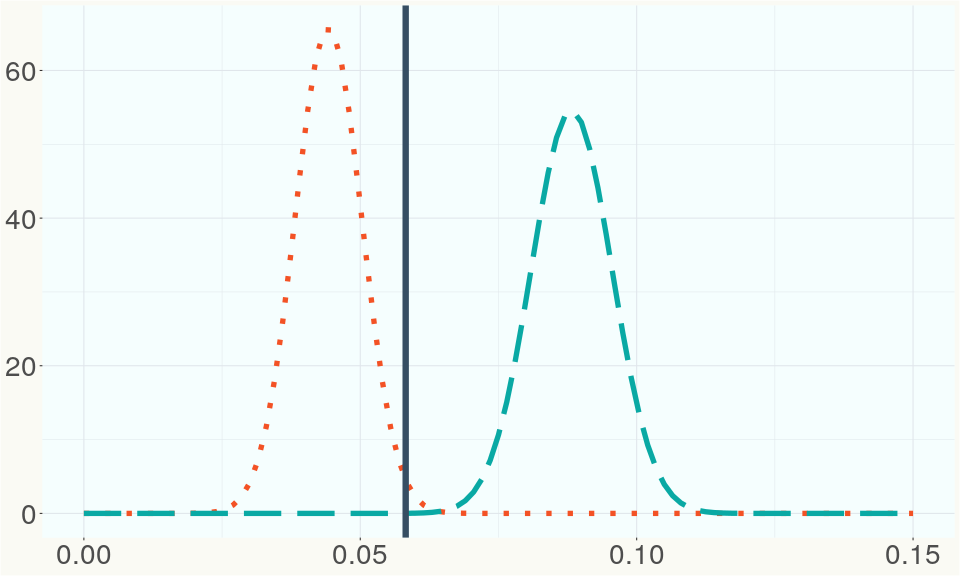
This chart represents the Illumina sequence coverage over the Bt/Bd allele. These are the three regions in the cannabis genome that impact THCA, CBDA, CBGA production. Coverage over the Active CBDAS gene is highly correlated with Type II and Type III plants as described by Etienne de Meijer. Coverage over the THCA gene is highly correlated with Type I and Type II plants but is anti-correlated with Type III plants. Type I plants require coverage over the inactive CBDA loci and no coverage over the Active CBDA gene. Lack of coverage over the Active CBDA and Active THCA allele are presumed to be Type IV plants (CBGA dominant). While deletions of entire THCAS and CBDAS genes are the most common Bt:Bd alleles observed, it is possible to have plants with these genes where functional expression of the enzyme is disrupted by deactivating point mutations (Kojoma et al. 2006).
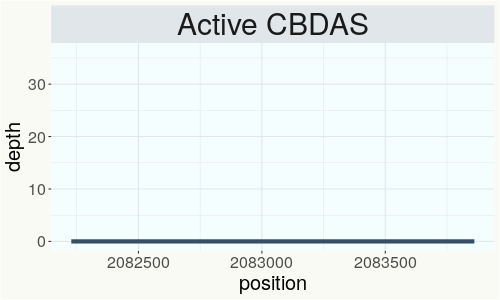
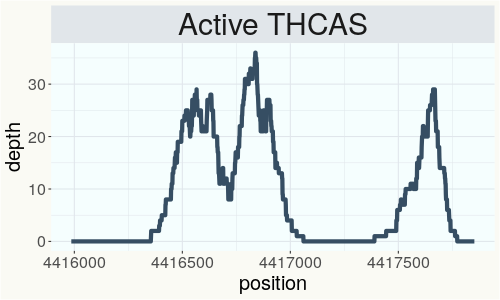
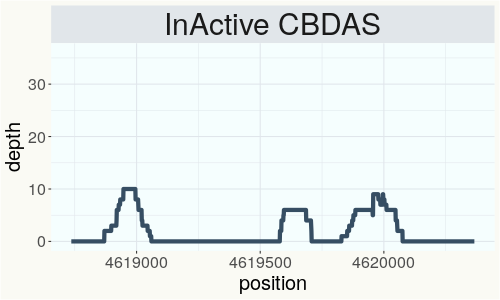
This chart represents the Illumina sequence coverage over the CBCA synthase gene.
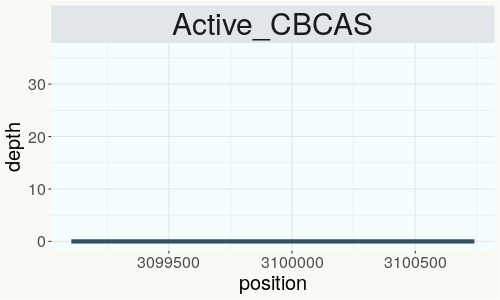
Variants (THCAS, CBDAS, and CBCAS)
Variants (Select Genes of Interest)
| PKSG-2a | c.67T>A | p.Phe23Ile | missense variant | moderate | contig700 | 1945567 | A/T | |
| PKSG-2a | c.31A>T | p.Thr11Ser | missense variant | moderate | contig700 | 1945603 | T/A | |
| PKSG-2b | c.31A>T | p.Thr11Ser | missense variant | moderate | contig700 | 1951851 | T/A | |
| PKSG-4b | c.496A>G | p.Lys166Glu | missense variant | moderate | contig700 | 2721177 | T/C | |
| PKSG-4b | c.489delT | p.Phe163fs | frameshift variant | high | contig700 | 2721183 | CA/C | |
| PKSG-4b | c.485A>G | p.Lys162Arg | missense variant | moderate | contig700 | 2721188 | T/C | |
| aPT4 | c.775delT | p.Tyr259fs | frameshift variant | high | contig121 | 2831380 | AT/A |
|
| aPT1 | c.406A>G | p.Ile136Val | missense variant | moderate | contig121 | 2839605 | A/G | |
| aPT1 | c.629C>T | p.Thr210Ile | missense variant | moderate | contig121 | 2840237 | C/T |
Nearest genetic relatives (All Samples)
- 0.003 Skunk#18 (RSP11030)
- 0.219 RKM-2018-023 (RSP11115)
- 0.228 CPH (RSP11367)
- 0.235 Square Wave (RSP11344)
- 0.237 Trump x Trump (RSP11466)
- 0.241 UnObtanium (RSP11611)
- 0.246 Durban Poison #1 (RSP11013)
- 0.246 Glueberry OG (RSP11222)
- 0.252 Golden Goat 2 (RSP10991)
- 0.254 Cheese (RSP10460)
- 0.255 Rest (RSP11377)
- 0.258 CBG-#40 (RSP11444)
- 0.259 Durban Poison #1 (RSP10996)
- 0.261 Domnesia (RSP11184)
- 0.261 Charlotte Dream (RSP11412)
- 0.263 Gold Cracker (RSP11041)
- 0.264 RKM-2018-003 (RSP11094)
- 0.265 1971 1974 Skunk (RSP12498)
- 0.265 T S A G E (RSP11351)
- 0.265 Grape Slurpy Runtz (RSP11499)
Most genetically distant strains (All Samples)
- 0.486 Cherry Blossom (RSP11317)
- 0.474 Cherry Blossom (RSP11335)
- 0.473 Cherry Blossom (RSP11308)
- 0.467 Cherry Blossom (RSP11318)
- 0.465 Cherry Blossom (RSP11330)
- 0.464 Cherry Blossom (RSP11311)
- 0.462 Cherry Blossom (RSP11306)
- 0.460 Cherry Blossom (RSP11323)
- 0.444 Cherry Blossom (RSP11328)
- 0.443 Cherry Blossom (RSP11325)
- 0.442 Cherry Blossom (RSP11322)
- 0.442 Cherry Blossom (RSP11334)
- 0.440 Tiger Tail -30- (RSP11484)
- 0.439 CS Indica (RSP11658)
- 0.439 Cherry Blossom (RSP11298)
- 0.437 Cherry Blossom (RSP11333)
- 0.435 Feral (RSP11205)
- 0.435 CS (RSP11208)
- 0.435 Cherry Blossom (RSP11314)
- 0.434 Cherry Blossom (RSP11326)
Nearest genetic relative in Phylos dataset
- Overlapping SNPs:
- 110
- Concordance:
- 70
Nearest genetic relative in Lynch dataset
- Overlapping SNPs:
- 17
- Concordance:
- 15
Blockchain Registration Information
- Transaction ID
-
a60cf28d7a740767
7c13b50245f977c4 8a73be7e54d4e087 194b337e651d8b85 - Stamping Certificate
- Download PDF (843.2 KB)
- SHASUM Hash
-
9aea893ec5430702f384b43cfff424c4 600c8263f99d697b 0062d4152b462cf3